A roadmap template can serve as a helpful guide for product managers. Especially when looking for a broad-strokes idea of what the final output of their roadmap should look like. However, many PMs think of roadmap templates as pre-formatted documents where they fill in the details.
Describing roadmap templates in this way is actually a misnomer. That’s because a roadmap, much like a book manuscript, is always a unique strategic document. They provide the skeleton framework to tease out the story, and vision product managers are trying to convey.
Roadmap Templates Are Models for Inspiration, Not Pre-Formatted Documents Ready for Your Details
Creating a roadmap from scratch can be a slow and difficult process. If you are using the wrong tools, as most product managers still do, leaning on a template to get things started has obvious appeal. This is one of the reasons that roadmap platforms like ProductPlan are so effective. They can help a product manager create a new roadmap quickly and with minimal manual effort and update it anytime just as easily.
But the idea of looking for a “roadmap template” is probably not the most effective way to think of this process. Here’s why.
Look at the screenshot below, which depicts a sample product roadmap template.
Sample Roadmap Template
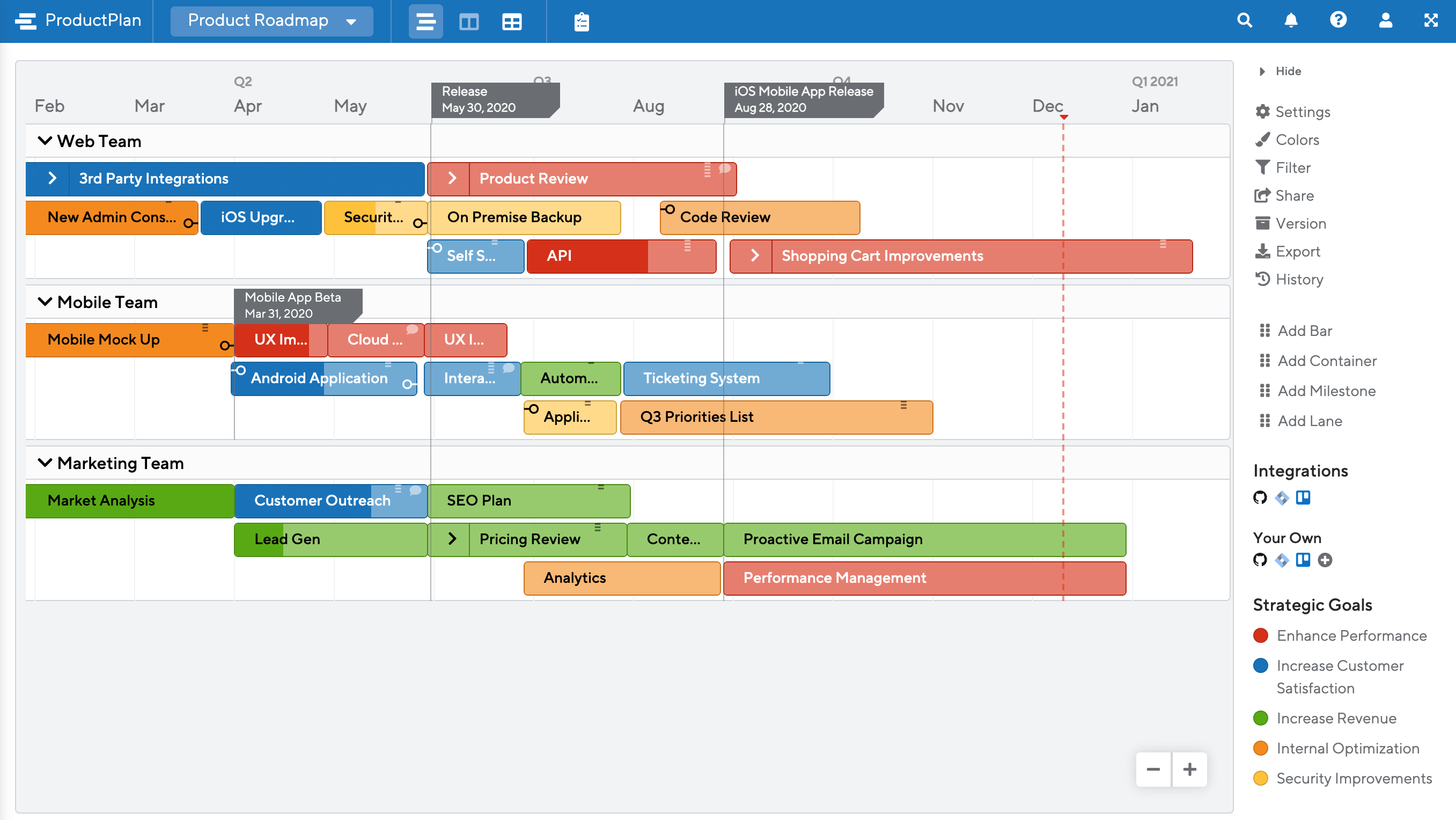
As a roadmap template, this sample offers plenty of useful ideas that a product manager can follow. Mainly for inspiration or for helping to organize and prioritize her own thoughts.
For example, this roadmap template groups together multiple epics — such as “Security 2.0” and “New Admin Console” — under a common swimlane. In this case, those epics are the responsibility of the “Web Team.” All these items layout against a set of broad dates, visible by quarter and month. A glance will also reveal the projected start and end periods for each epic under each roadmap theme.
The epics are color-coded according to a “Strategic Goals” legend on the roadmap, allowing glances. Ones that will reveal, for example, green-colored epics focus on increasing customer satisfaction, and purple items gear toward boosting revenue.
Such a roadmap template can be a valuable guide for inspiration on how to organize a roadmap based on goals, timelines, themes, epics, and individual features contained in each epic.
In most cases, you cannot simply cut and paste your own details into a sample roadmap template like the one above. After all, the themes, epics, and specific metrics on your legend will differ from the sample roadmap template. You also have a different implementation team structure and varied goals.
Types of Roadmap Templates
All roadmaps are not created equal, and neither are the templates. That’s why a generic template isn’t nearly as useful as one tailored to your particular situation. To build your roadmap on a solid foundation, you should first consider exactly what you’re trying to roadmap in the first place.
Are you launching a new product, managing an entire portfolio, or kicking off a complex IT project? Or maybe you’re planning out an HR initiative, marketing strategy, or are in DevOps? These each have unique elements that a specific template can make easier.
Worried that an Agile development setting and roadmaps can’t coexist? That’s far from the truth. Roadmaps can detail the strategy that’s driving those Agile activities while mapping out each sprint and milestone.
Your roadmap’s intended audience can also play a significant factor in which template makes the most sense for the occasion. Executives and customers are looking for very different things from a roadmap. While engineering is going to need something far more detail-oriented.
With the right roadmapping tool, you can create custom views to use the same base roadmap and optimize the view for different audiences.
Stop Dating Yourself
There’s a common preconception that the most important things on a product roadmap are deliverables and due dates. While this is sometimes the case, there are many reasons to be a little vaguer in your roadmap.
Depending on the situation, you have a few roadmap styles to choose from in this department. While there are roadmap templates for timeline-based plans with set milestones and targets, this isn’t the only option.
Date-Free Roadmap
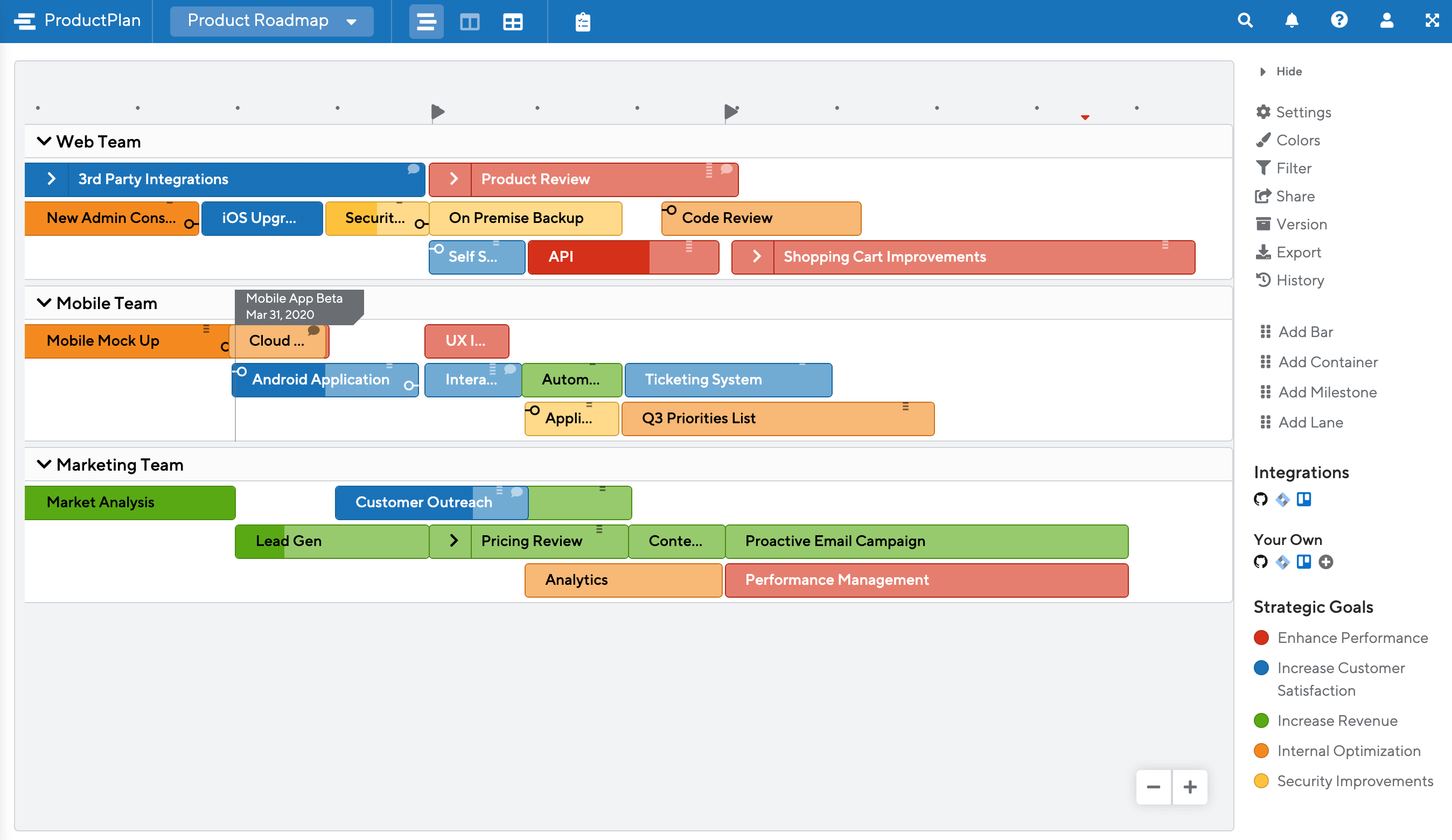
Date-less roadmap ProductPlan Template
You can also select a date-free roadmap that focuses on the product vision that forgoes any specific dates. This prevents setting any false expectations.
The sequential ordering of initiatives will have to be enough to satisfy your audience in cases where it’s all about strategy and priorities rather than the calendar, by not spelling out exactly what will ship when you have more flexibility to react to customer feedback and market developments without breaking any promises or damaging your credibility.
Kanban
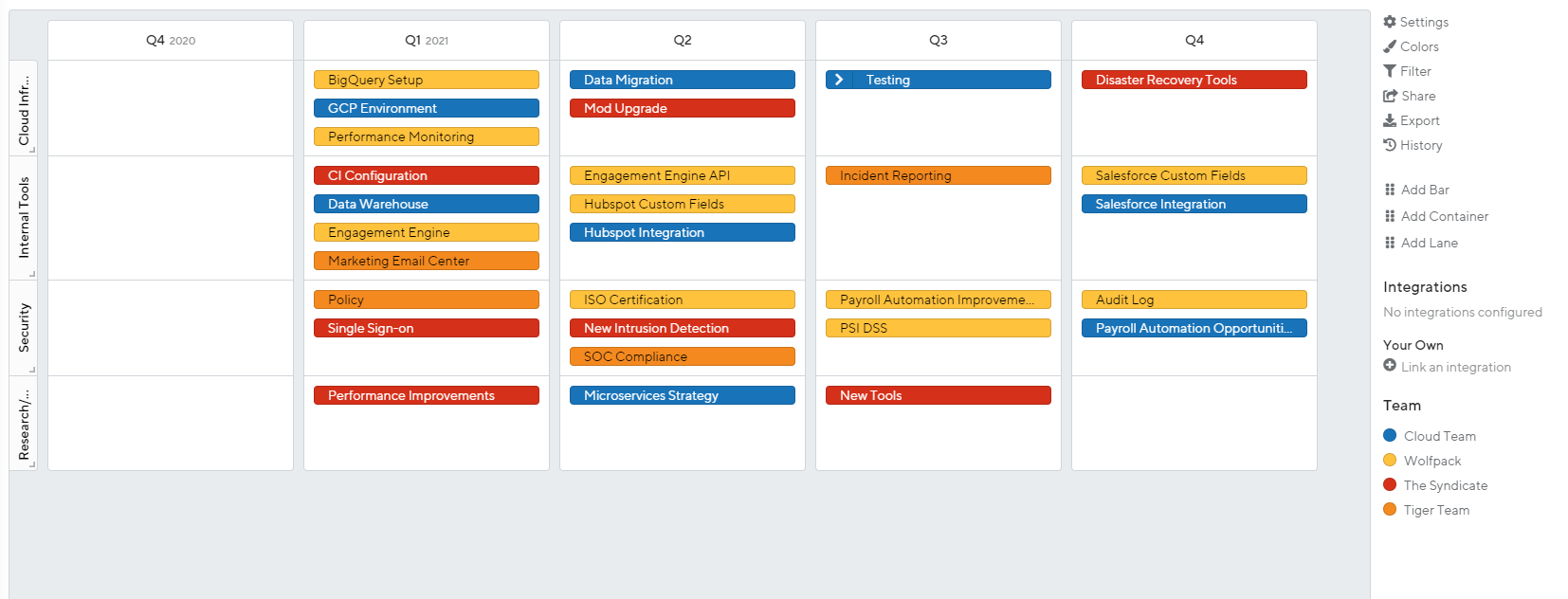
There’s also the Kanban route. This roadmap format tells the audience what stage each item is in, such as in the backlog, under development, or delivered. It’s a constantly updated snapshot that lets people know what’s worked on, what’s next up, what’s out the door, and what’s not happening any time soon.
If you’re not sure whether or not your roadmap needs a timeline at all, that decision all begins with your ability to elevate above the tactical elements to focus on strategy.
Dive into Swimlanes
Most roadmap templates will allow you to place different items into a separate track. These tracks are commonly referred to as swimlanes. Depending on your roadmap structure, these can be based on a few different parameters.
Team Workstreams
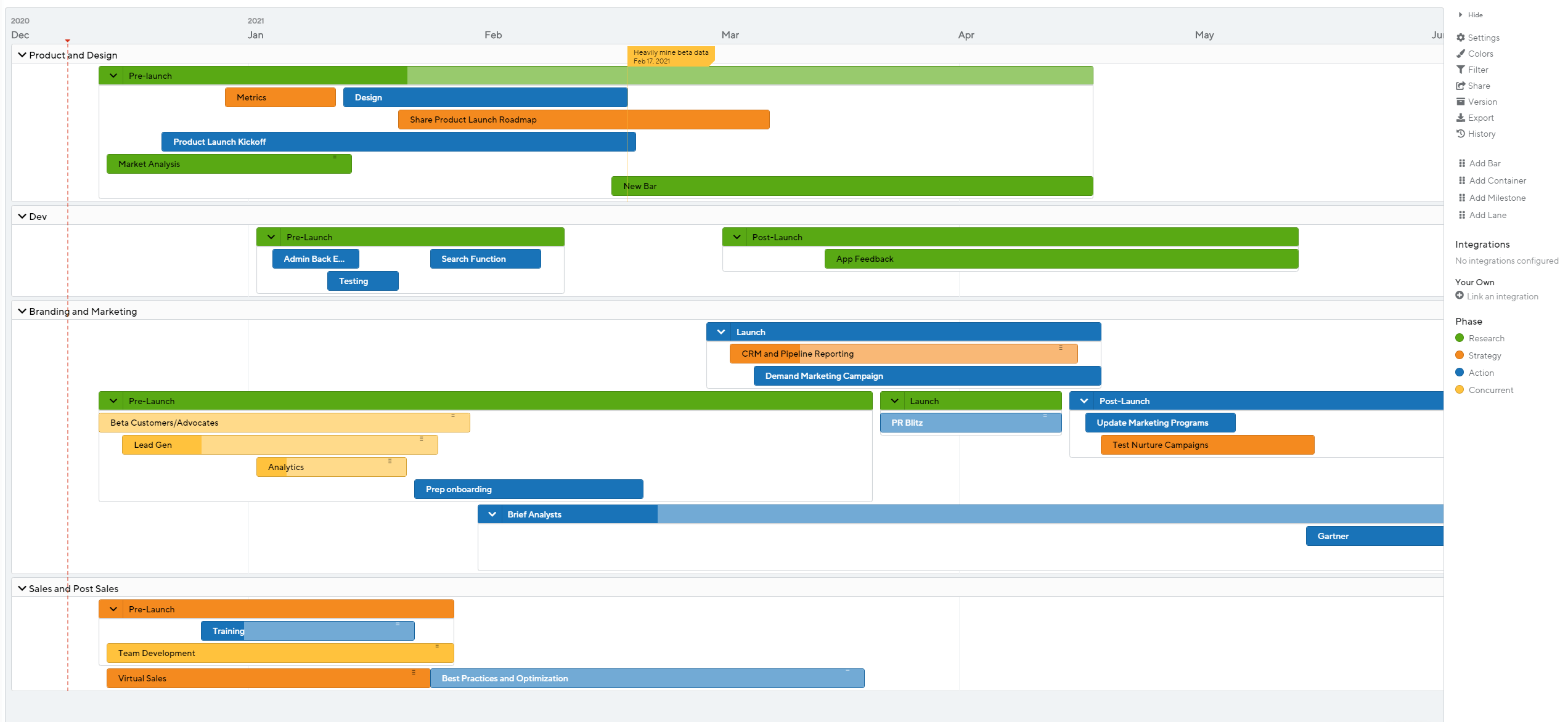
In these templates, each responsible party has its own swimlane containing which items are on their plate for each phase of the project. These teams could be generic (i.e., Engineering, QA, Marketing), or they could be more granular in a larger organization (i.e., Architecture, UX, Mobile, Web, or even specific scrum teams).
You will often see project items appearing multiple times on the roadmap as they graduate from one phase to another. This format is best suited to see who is working on what resources need to be moved.
Product Swimlanes
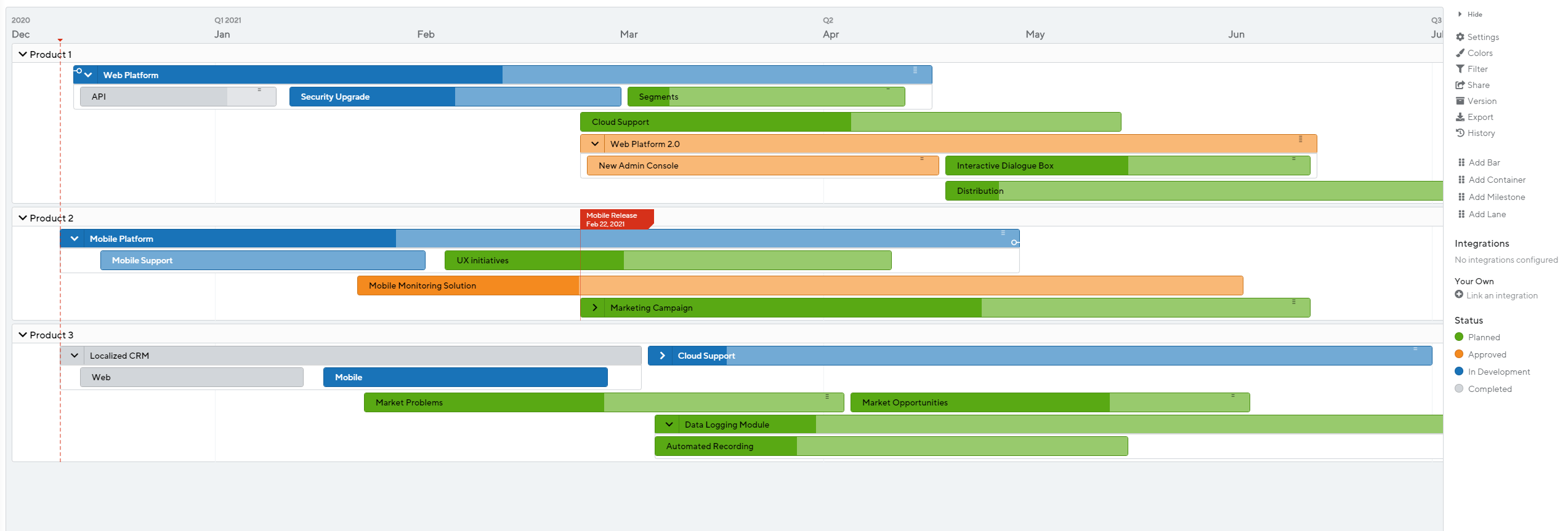
Each product will get its own swimlane and likely only list pretty general features or themes in a multi-product or portfolio roadmap template. This gives a higher-level of view of what each product is prioritizing and working on.
This view can be helpful for strategic alignment across the portfolio, as well as for resource planning. Sales and marketing may also appreciate this view to create a coordinated calendar instead of treating each product like a silo.
Goal/Objective/Theme Swimlanes

Unlike the previous, more tactical view of things, organizing swimlanes around these more strategic elements. This kind of roadmap shifts the emphasis from “what we’re gonna build” to “why we’re focusing on this.”
Swimlanes structured around these prioritized areas provide context and rationale. Signaling to everyone in the audience what the organization is trying to accomplish and how it’s planning to get there. While segmenting items this way is one method of telling that story, you can also employ another visual element to achieve this.
Be Legendary
The other visual indicator at your disposal in a roadmap template is color coding items and leveraging a legend to add an entirely new dimension to things. Just like swimlanes used to indicate which team or goal or theme an item belongs to, denoting each item’s purpose or who’s working on it can also be accomplished this way.
Best of all, you can combine swimlanes and legends to communicate even more information and context. For example, you can have your swimlanes based on teams and your legend based on themes, explaining who’s building it and why all in one glance.
Three Ways to Use a Roadmap Template to Help Improve Your Own Roadmaps
Here are a couple of ways that roadmap templates can both speed the creation of your roadmap and improve its quality and usability.
1. Get inspired
Every roadmap will be a custom document. For that reason, you cannot expect to copy an existing roadmap and replace some of its details with your own. In this sense, a roadmap template won’t be much help. (There is one exception to this, however, which we will discuss below.)
But perhaps you are creating your first agile-based roadmap or a multiple-product roadmap, and you are not sure of where to begin or what the final output document should look like. In these cases, roadmap templates can be helpful. Here is a page filled with such sample roadmap templates, all generated using ProductPlan.
Once you’ve viewed these roadmap templates and gleaned some ideas from them, you will be in a much better position to begin crafting your own.
2. Build on an existing foundation
This is one exception to the notion that you generally do not want to treat an existing roadmap template as a pre-formatted document to start your own roadmap. If your organization uses the right product roadmap software, you will be able to copy an existing roadmap in your organization’s online account and use it to create a new one.
The value in this strategy is that all of the work you or your product colleagues have already done — establishing a set of strategic goals for tracking, applying scores to various initiatives, grouping stories or features under specific epics, etc. — can be automatically transferred into the new roadmap document. So if you want to create a roadmap for a new addition to your product suite, for example, you can leverage all of that work already completed on previous related roadmaps — using these documents as your roadmap templates — rather than having to recreate all of those details again for your new roadmap.
Roadmap templates can be precious in helping you draft your own roadmap quickly and easily in these senses.
3. Reframe your narrative
With a roadmap template based on themes or goals, you can completely change how you tell the story to stakeholders. Freed from the constraints of dates and specific features, the conversation can define and implement the corporate or product strategy.
Quit the feature factory approach and migrate to a feature-less roadmap with a theme-based roadmap template. Save the specifics for the project plans and Gantt charts. Use your roadmap to motivate your coworkers, entice customers, and excite the market while steering clear of overcommitting to anything.





